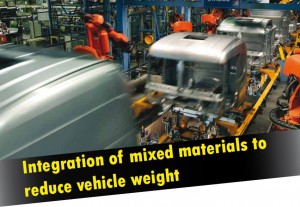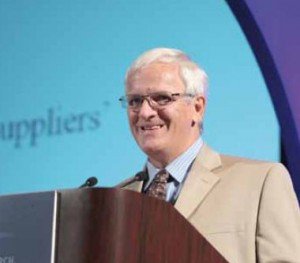By Jay Baron, President and CEO, Center for Automotive Research (CAR)*

The average vehicle weight has increased steadily since 1980. This is due to production of larger vehicles (SUVs). The average light vehicle in 2008 contained more than 2,000 pounds of steel, most of it conventional steel. High and medium strength steel, however, made up more than 10 per cent of the vehicle. The use of aluminum grew during 1995-2008, while that of iron castings declined.
The vehicle industry will continue to see more mixed materials (composites, aluminum, magnesium, high strength steel) – issues with joining and corrosion. It is going to be steel vehicle vs. aluminum intensive vehicle, looking for one-third mass reduction that is cost neutral but doesn’t recognize any realistic constraints in vehicle making.
In assessment of technologies for improving light-duty vehicle fuel economy, there are over 40 technologies involved. For the next 15 years, improvements in fuel economy are not technology limited but cost constrained.
The objective of the Coalition for Automotive Lightweighting Materials (CALM) is to support the cost-effective integration of mixed materials to achieve significant reductions in mass through the collaborative efforts of the material sectors and auto manufacturers.
Currently, OEMs are integrators of mixed materials. There is minimal independent, mixed material development. Material sectors are highly competitive, each conducting significant research that advances its own material. Challenges lie in design, joining, corrosion prevention, fabrication and long-term reliability.
 Individual material sectors have made impressive advances in individual materials – aluminum intensive, steel intensive and plastic intensive vehicles.
Individual material sectors have made impressive advances in individual materials – aluminum intensive, steel intensive and plastic intensive vehicles.
Lightweighting
Lightweighting materials are high strength steels, aluminum, composites and magnesium.
– Material substitution (incremental approach – regular practice)
– Material optimization (high risk, many engineering resources, expensive). For example, aluminum or carbon fiber intensive vehicles.
Less performance / content but increased crash-worthiness and ride / handling relates to smaller cars, fewer trucks and framed vehicles, and smaller powertrains.
Vehicles are made with more advanced materials to mitigate increasing weight (for fuel economy and handling) and for improving crash performance. Mass de-compounding is estimated at 30 per cent (secondary effects).
The most likely dramatic changes for the automotive market through 2025 could well be a result of mandates by the federal government to improve the fuel economy performance and vehicle safety.
The Center for Automotive Research (CAR) is involved in the research of significant issues that relate to the future direction of the global automotive industry. Its automotive industry research is done by four distinct groups – the Manufacturing, Engineering & Technology Group, Transportation Systems Analysis Group, Labor and Industry Group, and Sustainability & Economic Development Strategies.
CAR, based in Ann Arbor, MI, is a non-profit organization focused on a wide variety of important trends and changes related to the automobile industry at the international, federal, State and local levels. It conducts industry research, develops new methodologies, forecasts industry trends, advises on public policy, and sponsors multi-stakeholder communication forums.
In the field since 2003, CAR was formerly a division of the University of Michigan and has been conducting leading edge research and industry events throughout its 30+ year history.
* Presentation made during the recent visit of Indian journalists to CAR at Michigan